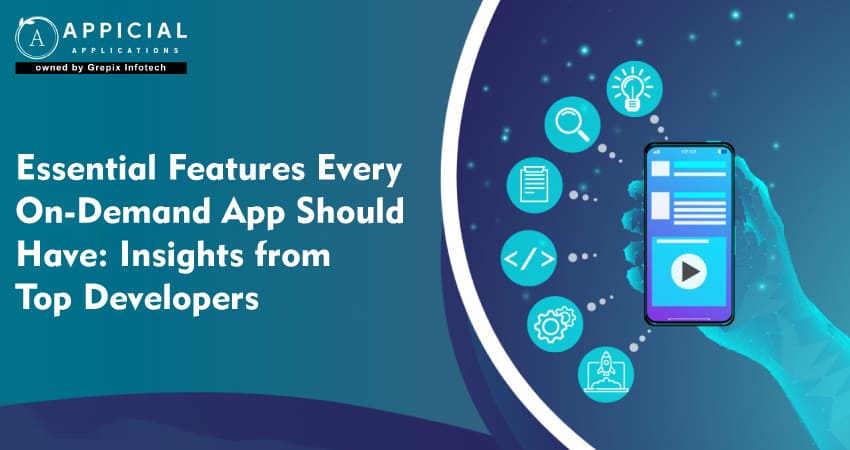
Essential Features Every On-Demand App Should Have
In the ever-evolving digital landscape, on-demand apps have revolutionized the way we access services. Whether it's hailing a ride, ordering food, booking a handyman, or renting accommodation, on-demand apps are making life easier, faster, and more convenient.
On-demand apps surged in popularity during the pandemic era. The Covid-19 crisis forced individuals and businesses to rely heavily on digital solutions for their needs. This challenging period accelerated the growth of on-demand app development.
Nowadays, it’s difficult to think of a product or service that can’t be ordered via smartphone. This shift has created a new landscape of opportunities, benefiting both consumers and businesses, whether startups or established enterprises.
However, building a successful on-demand app requires more than just an idea. It demands a careful consideration of features that enhance user experience, ensure reliability, and foster trust.
In the digital age, on-demand apps have transformed how we access services, offering convenience and speed. Essential features for a successful on-demand app include a user-friendly interface, real-time tracking, secure payment gateways, efficient matching algorithms, and robust security measures. Personalization, in-app communication, advanced search, and geo-fencing enhance user experience, while scalability and regular updates ensure performance. Loyalty programs and data analytics drive engagement and growth. By focusing on these elements, developers can create apps that meet modern consumer expectations, ensuring both user satisfaction and business success.
What is an on-demand application?
An on-demand application is a digital platform that allows users to access services or products instantly and conveniently, typically through a mobile app or website. These applications connect consumers with service providers or product vendors in real-time, enabling seamless transactions with just a few taps on a device. On-demand apps cover a wide range of industries, including transportation (like ride-hailing apps), food delivery, home services, healthcare, and more. They leverage technology to provide efficient, personalized, and user-friendly solutions, meeting the increasing demand for immediate access and convenience in today's fast-paced world.
Why Are On-Demand Apps In Trend?
On-demand apps are in trend due to their ability to cater to the modern consumer's need for convenience, speed, and efficiency. In today's fast-paced world, people value the ability to access services and products instantly, without the hassle of long waits or complicated processes. On-demand apps leverage advanced technology to offer real-time solutions, whether it's ordering food, booking a ride, or scheduling a home service. This immediacy aligns with the lifestyle of consumers who seek quick, reliable, and personalized experiences.
Moreover, the pandemic accelerated the adoption of digital solutions, making on-demand services even more crucial. As people were confined to their homes, the reliance on these apps for essential services grew significantly. Businesses quickly adapted to this shift, expanding their digital presence and improving their on-demand offerings to meet the surge in demand.
From an economic perspective, on-demand apps present a lucrative opportunity for entrepreneurs and established businesses alike. They open up new revenue streams and markets, enabling companies to reach a broader audience with minimal overhead costs compared to traditional brick-and-mortar operations. Additionally, the data-driven nature of these apps allows businesses to understand consumer behavior better, leading to more targeted marketing and improved customer retention.
Overall, the combination of consumer demand for instant gratification, the accelerated digital shift due to the pandemic, and the economic advantages for businesses has propelled on-demand apps to the forefront of contemporary trends.
Essential features of on-demand app
Here, we delve into the essential features every on-demand app should have, drawing insights from top developers in the industry.
1. User-Friendly Interface
Simplicity is Key
A user-friendly interface is the cornerstone of any successful on-demand app. Users should be able to navigate the app with ease, without needing a tutorial. The design should be intuitive, with a clear layout and straightforward navigation. Top developers emphasize the importance of a clean, uncluttered interface that focuses on core functionalities.
Seamless Onboarding
The onboarding process should be quick and effortless. Users should be able to sign up or log in using social media accounts, email, or phone numbers. Offering a guest mode can also attract users who want to explore the app without committing to a registration process initially.
2. Real-Time Tracking and Notifications
Live Tracking
One of the most appreciated features in on-demand apps is real-time tracking. Whether it's tracking a food delivery, a taxi, or a service provider, users want to know the status of their request in real-time. Implementing GPS technology to provide live updates builds trust and enhances user satisfaction.
Push Notifications
Push notifications are essential for keeping users informed about their orders, promotions, and app updates. However, it's crucial to balance the frequency and relevance of notifications to avoid overwhelming users. Personalized notifications based on user behavior and preferences can significantly enhance engagement.
3. Secure Payment Gateway
Multiple Payment Options
Offering multiple payment options, including credit/debit cards, digital wallets, and even cash on delivery, caters to a broader audience. The payment process should be seamless and secure, ensuring user data protection through encryption and secure payment gateways.
Payment Confirmation and Receipts
After every transaction, users should receive a confirmation and an electronic receipt. This adds a layer of transparency and allows users to keep track of their spending.
4. Rating and Review System
User Feedback
A robust rating and review system is crucial for maintaining quality and trust in your on-demand service. Users should be able to rate their experience and provide feedback on the service. This not only helps in improving the service quality but also builds credibility among new users.
Service Provider Ratings
Allowing users to view the ratings and reviews of service providers before making a selection helps in making informed decisions. It encourages service providers to maintain high standards and strive for better performance.
5. Efficient Matching Algorithm
Intelligent Matching
An efficient matching algorithm that quickly connects users with the nearest and most suitable service providers is vital. The algorithm should consider factors such as availability, proximity, and user preferences to ensure quick and accurate matches.
Machine Learning Integration
Incorporating machine learning can enhance the matching process by learning from past user interactions and improving the accuracy of matches over time. This leads to higher satisfaction rates and repeat usage.
6. In-App Communication
Messaging and Calling
Providing in-app communication options, such as messaging and calling, allows users to contact service providers without leaving the app. This feature enhances coordination and resolves issues promptly, leading to a smoother user experience.
Customer Support
A responsive customer support system, accessible through the app, is essential for addressing user concerns and queries. Offering support through chat, email, or phone ensures users have multiple channels to seek help when needed.
7. Personalization and Customization
User Preferences
Personalization enhances user engagement by tailoring the app experience to individual preferences. This can include customized recommendations, saved preferences, and personalized notifications based on user behavior.
Profile Management
Allowing users to manage their profiles, view order history, and update preferences empowers them to have control over their app experience. It also facilitates a more personalized interaction with the app.
8. Advanced Search and Filters
Search Functionality
An advanced search functionality helps users find exactly what they are looking for with minimal effort. Implementing filters and sorting options based on categories, price, ratings, and other criteria enhances the search experience.
Voice Search
Incorporating voice search can further simplify the search process, especially for users who prefer hands-free interactions or have difficulty typing.
9. Geo-Fencing and Location-Based Services
Targeted Services
Geo-fencing allows apps to provide location-specific services and notifications. For instance, users can receive notifications about nearby deals, service availability, or local promotions, enhancing the relevance and convenience of the app.
Safety and Verification
Location-based services can also enhance safety and verification. For example, confirming the user's location before initiating a service ensures the accuracy and reliability of the request.
10. Scalability and Performance
Robust Backend
A robust backend infrastructure ensures that the app can handle a large number of users and transactions simultaneously without performance issues. Scalability is crucial for accommodating growth and ensuring a smooth user experience even during peak times.
Regular Updates
Regular updates and maintenance are essential for keeping the app running smoothly and securely. Top developers stress the importance of monitoring performance and promptly addressing any bugs or issues.
11. Loyalty Programs and Discounts
Rewards and Incentives
Loyalty programs and discounts encourage repeat usage and customer retention. Offering rewards, referral bonuses, and exclusive discounts can incentivize users to choose your app over competitors.
Promotional Campaigns
Running targeted promotional campaigns, such as limited-time offers or seasonal discounts, can attract new users and boost engagement among existing ones.
12. Data Analytics and Insights
User Behavior Analysis
Analyzing user behavior and interactions with the app provides valuable insights into preferences and pain points. This data can inform feature enhancements, marketing strategies, and overall app improvement.
Performance Metrics
Monitoring key performance metrics, such as user acquisition, retention rates, and average transaction value, helps in assessing the app's success and identifying areas for growth.
13. Security and Privacy
Data Protection
Ensuring the security and privacy of user data is paramount. Implementing robust security measures, such as encryption, secure APIs, and regular security audits, protects user information and builds trust.
Compliance with Regulations
Compliance with data protection regulations, such as GDPR or CCPA, is essential for operating in multiple regions. Ensuring transparency in data handling practices and obtaining user consent for data collection enhances credibility.
Conclusion
In the rapidly evolving digital era, the success of on-demand apps hinges on their ability to deliver seamless, efficient, and user-centric experiences. From a user-friendly interface to robust security measures, each feature plays a critical role in meeting the high expectations of modern consumers. Insights from top developers highlight the importance of real-time tracking, secure payment gateways, efficient matching algorithms, and personalized experiences in creating an app that not only attracts users but also retains them.
As the demand for instant access to services continues to grow, businesses must prioritize these essential features to stay competitive and relevant. A well-designed on-demand app can transform a simple idea into a thriving business by leveraging technology to solve real-world problems and enhance convenience for users.
By focusing on these core features and continuously innovating, developers and entrepreneurs can create on-demand apps that stand out in a crowded market. Whether you are a startup looking to make your mark or an established business aiming to expand your digital presence, incorporating these elements will ensure your app meets the needs of today's fast-paced, tech-savvy consumers.
In essence, the key to a successful on-demand app lies in understanding user needs, embracing cutting-edge technology, and maintaining a relentless focus on quality and reliability. By doing so, you can build a platform that not only serves immediate needs but also fosters long-term customer loyalty and business growth.
Launch your vision with our mobile app development company, where innovation meets excellence to create cutting-edge mobile solutions."





